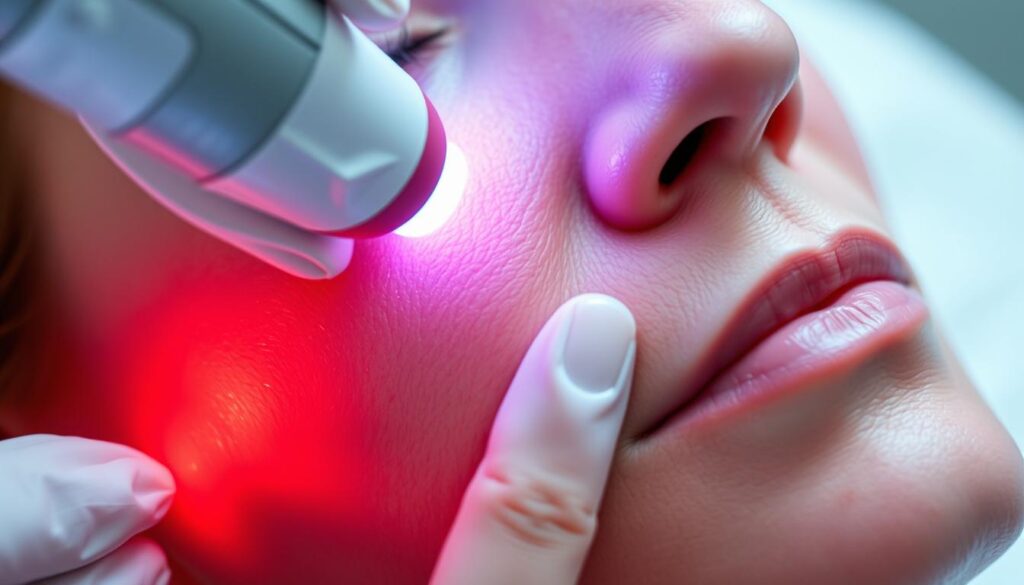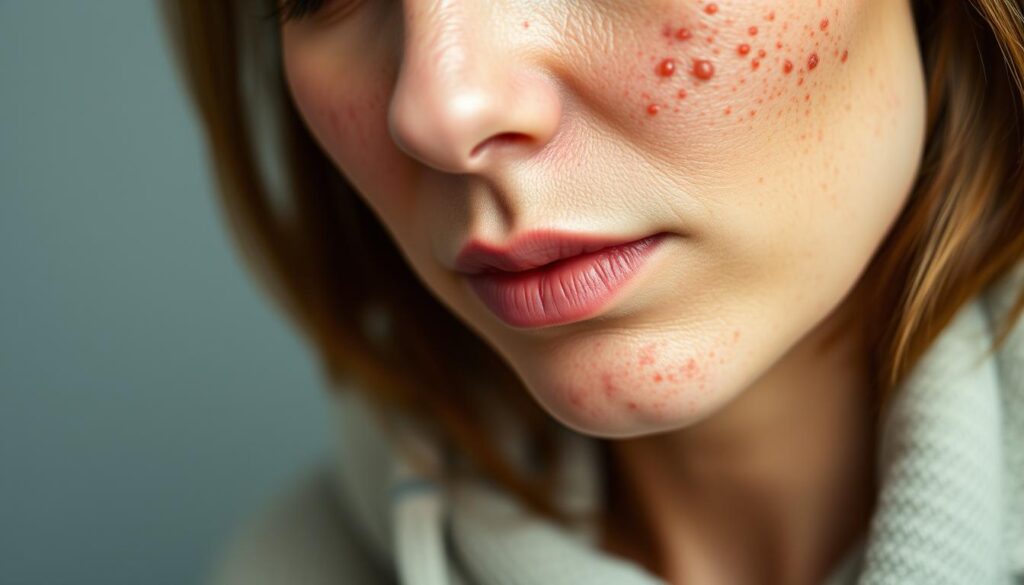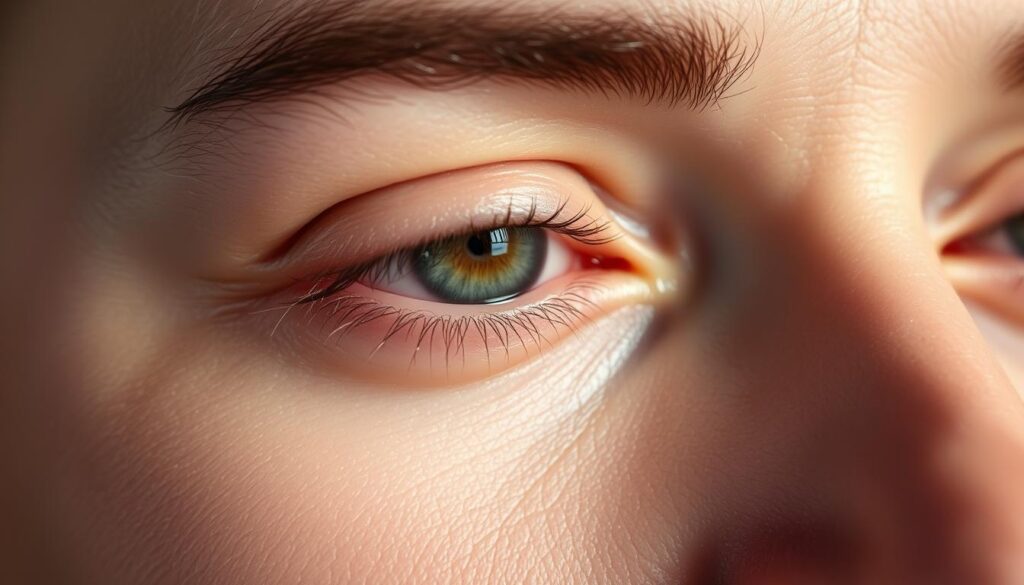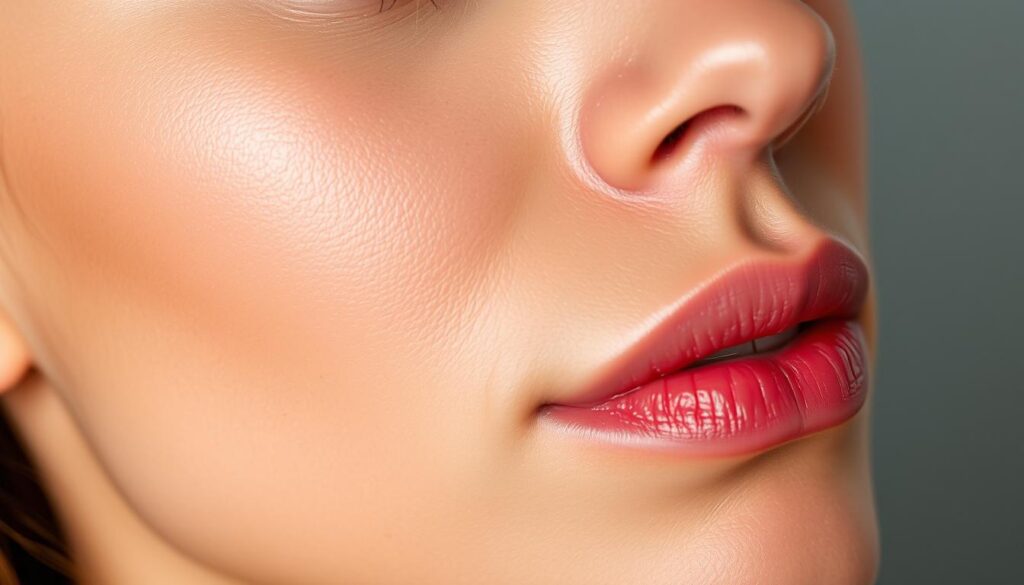If you’ve noticed redness or irritation on your face, you’re not alone. This common condition affects millions of people, particularly those over 30. It’s more prevalent in fair-skinned individuals and women, especially during menopause1.
This guide is here to help you understand the symptom rosacea and how to manage it effectively. From identifying triggers to exploring treatment options, we’ll cover everything you need to know. Whether it’s lifestyle changes or personalized routines, this resource is designed to support you.
Rosacea often appears on the nose, cheeks, and forehead, making it a visible concern for many. By following expert advice and recent research, you can take steps to reduce its impact on your daily life2.
Understanding Rosacea: An Overview
Have you ever wondered why your face sometimes turns red unexpectedly? This could be a sign of a chronic skin condition that affects millions. Known for persistent redness and occasional flare-ups, this issue is more common than you might think3.
What is Rosacea?
This condition is characterized by visible blood vessels and frequent flushing. It often starts with mild redness but can progress if left untreated4. While it’s sometimes mistaken for acne or sunburn, it’s a distinct issue that requires specific care.
Who is Affected by Rosacea?
Fair-skinned individuals are more prone to this skin concern, though it can affect people of all backgrounds3. Women, especially during menopause, are often diagnosed, but men may experience more severe symptoms5. Genetic and biological factors also play a role in its development4.
Understanding these basics is essential for managing the condition effectively. By recognizing the signs and knowing who is at risk, you can take proactive steps to reduce its impact.
Recognizing the Symptoms of Rosacea
Do you often experience sudden redness or warmth on your face? These could be early signs of a chronic skin condition. Recognizing these symptoms early can help you manage flare-ups more effectively6.
Facial Redness and Flushing
Persistent facial redness is one of the most common signs. You might notice a flushed appearance, especially on your cheeks, nose, or forehead. This flushing can last longer over time, becoming more noticeable7.
Inflammatory Bumps and Pustules
Small, red bumps or pus-filled pimples often appear. These can resemble acne but are distinct in their cause and treatment. Unlike acne, these bumps are typically accompanied by visible blood vessels8.
Ocular Symptoms and Other Signs
About half of those affected experience eye-related issues. These include dryness, irritation, or a bloodshot appearance8. Other subtle signs like burning, stinging, or swelling may also occur. Early recognition of these symptoms can lead to timely treatment and better management6.
Common Triggers and Causes of Rosacea
Understanding what sparks flare-ups can help you take control of your skin health. Many factors, both external and internal, can contribute to this condition. By identifying these triggers, you can better manage your skin and reduce discomfort.
Environmental and Lifestyle Triggers
Your surroundings and daily habits play a significant role. Sun exposure, wind, and extreme temperatures are common culprits. These elements can irritate your skin and cause blood vessel dilation, leading to redness and flushing2.
Lifestyle choices also matter. Stress, hot drinks, and spicy foods are known to aggravate the condition. In fact, 67% of patients reported fewer flare-ups by managing stress effectively9. Alcohol and certain skincare ingredients, like fragrance and menthol, can also worsen symptoms10.
Genetic and Biological Factors
Your genes and biology may also be at play. Research shows that irregular immune responses and blood vessel dilation are linked to this condition2. Additionally, a microscopic mite called Demodex folliculorum is found in higher numbers on affected skin, potentially triggering inflammation10.
Family history and hormonal changes, such as menopause, can increase your risk. Systemic conditions like high blood pressure have also been identified as contributing factors9. Recognizing these triggers is the first step toward effective management.
Effective Treatments and Therapies for Rosacea
Managing persistent facial redness can feel overwhelming, but effective treatments are available. With the right approach, you can reduce inflammation and improve your skin’s appearance. Let’s explore the options, from medications to advanced procedures.

Topical and Oral Medications
Topical treatments like metronidazole and azelaic acid are often the first line of defense. These help reduce redness and inflammation over time11. For more severe cases, oral antibiotics such as doxycycline may be prescribed for 4 to 6 weeks12.
Brimonidine tartrate gel is another option, offering quick relief from redness within 30 minutes11. While these medications are effective, they may require ongoing use to maintain results.
Laser and Procedural Options
For visible blood vessels and long-term redness, laser treatment is a popular choice. This procedure targets dilated vessels, improving the skin’s appearance12. Most patients need 2 to 4 sessions for optimal results11.
Intense pulsed light (IPL) is another option, though it’s often considered cosmetic and may not be covered by insurance12. These advanced treatments are best discussed with a dermatologist to tailor a plan to your needs.
| Treatment Type | How It Works | Duration |
|---|---|---|
| Topical Medications | Reduces inflammation and redness | Several weeks |
| Oral Antibiotics | Controls severe symptoms | 4-6 weeks |
| Laser Treatment | Targets visible blood vessels | 2-4 sessions |
Working with a dermatologist ensures you receive a personalized treatment plan. Whether it’s medication or laser therapy, the right approach can make a significant difference in managing your skin health.
Managing Pain and Discomfort with Rosacea
Dealing with discomfort from facial redness can be challenging, but there are ways to ease the irritation. More than 90% of people with this condition report physical discomfort, making it a common concern13. Understanding the causes and taking proactive steps can help you feel better.
One of the most frequent issues is a burning or stinging sensation. This often occurs due to changes in vessel dilation, which can make your skin more sensitive14. Flare-ups, triggered by factors like spicy foods or stress, can worsen this discomfort13.
To manage these symptoms, start with your skincare routine. Use a mild, fragrance-free cleanser and lukewarm water to reduce irritation13. Waiting five to ten minutes after washing before applying medication can also help minimize stinging13.
Medical treatments like topical medications or laser therapy can provide relief. Nearly 70% of individuals find significant improvement through these methods13. Timely intervention is key to reducing the severity of discomfort during a flare.
Finally, adopt protective measures like avoiding known triggers and using sunscreen daily. These small changes can make a big difference over time. By combining self-care with medical strategies, you can manage pain and improve your skin’s comfort.
Rosacea: Symptoms, Triggers, and Skincare Tips
Finding the right skincare routine can make a big difference for sensitive skin. With the right product choices, you can soothe irritation and protect your skin from common triggers. A personalized approach ensures your routine works for your unique needs.
Choosing the Right Products
Start with a gentle cleanser designed for sensitive skin. Look for fragrance-free options that won’t strip your skin’s natural moisture. Moisturizers with ceramides or niacinamide can help strengthen your skin barrier and reduce redness15.
Always patch test new products before full application. Apply a small amount to your inner arm and wait 24 hours to check for reactions. This step ensures the product is safe for your skin16.
Managing Visible Redness
For immediate relief, consider using a color-correcting patch or green-tinted makeup. These tools neutralize redness and create a more even complexion. Mineral-based makeup is less likely to irritate sensitive skin17.
Pair these strategies with a simple routine: cleanse twice daily, moisturize, and apply sunscreen. This approach minimizes irritation and keeps your skin healthy15.
| Product Type | Benefits | Key Ingredients |
|---|---|---|
| Gentle Cleanser | Removes impurities without irritation | Aloe vera, ceramides |
| Moisturizer | Strengthens skin barrier | Niacinamide, hyaluronic acid |
| Color-Correcting Patch | Reduces visible redness | Green pigments, soothing agents |
By focusing on gentle, effective skincare, you can manage your skin’s needs and reduce flare-ups. Always consult a dermatologist for tailored advice and recommendations.
Skincare Routines and Protective Measures for Rosacea
Taking care of sensitive skin requires a thoughtful approach to daily routines. By focusing on gentle techniques and the right products, you can minimize irritation and maintain a healthy complexion. Let’s explore how to build a skincare routine that works for you.
Gentle Cleansing Techniques
Start with a mild, fragrance-free cleanser designed for sensitive skin. Use lukewarm water to avoid stripping natural oils, which can lead to dryness and irritation18. Avoid harsh scrubbing or washcloths, as these can aggravate your skin. Instead, use your fingertips to gently massage the cleanser into your face.
After cleansing, pat your skin dry with a soft towel. Wait a few minutes before applying moisturizer to allow your skin to absorb the product fully. This step helps lock in moisture and strengthens your skin barrier19.
Sunscreen and Protective Skincare
Daily protection from the sun is essential. Choose a broad-spectrum sunscreen with an SPF of 30 or higher. Mineral-based options with zinc oxide or titanium dioxide are less likely to irritate sensitive skin18. Apply it generously every morning, even on cloudy days, to shield your skin from harmful UV rays.
In addition to sunscreen, consider wearing a wide-brimmed hat and sunglasses for extra protection. These accessories help reduce direct sun exposure, which is a common trigger for flare-ups20.
Dietary choices also play a role in skin health. Avoid spicy food and hot beverages, as they can increase redness and sensitivity20. Opt for cooling, hydrating foods like cucumbers and watermelon to support your skin from within.
By combining gentle cleansing, sun protection, and mindful dietary habits, you can create a routine that keeps your skin calm and healthy. Small, consistent steps make a big difference over time.
Lifestyle Adjustments to Minimize Flare-Ups
Making small changes in your daily habits can significantly reduce skin sensitivity. Lifestyle modifications are just as important as medical treatments in managing flare-ups. By identifying and avoiding triggers, you can take control of your skin health and feel more comfortable.
Stress Management Strategies
Stress is a common trigger for flare-ups, but there are ways to manage it effectively. Activities like meditation, yoga, and regular exercise can help reduce stress levels21. These practices not only calm your mind but also improve overall well-being.
Regular physical activity is a natural stress reliever and can help reduce inflammation over time21. Just remember to maintain a consistent body temperature during exercise to prevent flare-ups21.
Dietary Changes to Consider
Your diet plays a significant role in managing skin sensitivity. Avoiding alcohol, especially red wine and beer, can help minimize flare-ups22. Spicy foods and high-histamine items like aged cheese should also be limited21.
Instead, focus on anti-inflammatory foods like green tea and fresh vegetables. These can help soothe your skin and reduce redness21. Experimenting with your diet is key to finding what works best for you.
Protecting your skin from the sun is another essential step. Use a broad-spectrum sunscreen with an SPF of 30 or higher to shield your skin from harmful UV rays22. Wearing protective clothing like wide-brimmed hats can also help minimize triggers21.
Remember, what works for one person may not work for another. Personal experimentation is crucial in finding the right balance. By making these adjustments, you can reduce the frequency and severity of flare-ups and enjoy healthier skin.
Working with Your Healthcare Provider
Navigating a chronic skin condition can feel overwhelming, but professional guidance can make a world of difference. A dermatologist can help you manage your symptoms effectively and create a plan tailored to your needs. Collaboration with a healthcare provider ensures you receive the best care possible23.
When to See a Dermatologist
If you notice persistent redness, especially on your nose or cheeks, it’s time to consult a professional. Worsening symptoms, such as bumps or visible blood vessels, also warrant a visit24. Early intervention can prevent the condition from progressing and improve your quality of life25.
Eye-related issues, like dryness or irritation, are another sign to seek help. About half of those affected experience these symptoms, which can worsen without proper treatment24.
Tailored Treatment Plans
Every case is unique, and a dermatologist can design a plan that works for you. This may include topical medications, oral antibiotics, or advanced procedures like laser therapy23. Regular check-ups allow for adjustments to your plan, ensuring long-term success25.
Expert guidance also helps you manage triggers, such as sun exposure or environmental factors. By working together, you can reduce flare-ups and maintain healthier skin23.
Proactive communication with your healthcare provider is key. Share your concerns and experiences to optimize your treatment and achieve the best results25.
Interesting Facts and Research Updates on Rosacea
Recent advancements in dermatology are shedding new light on the complexities of facial redness. Scientists are uncovering groundbreaking insights into its causes and developing innovative treatments. These discoveries offer hope for more effective management and improved quality of life.
Recent Research Breakthroughs
One of the most exciting findings involves the role of mites in skin health. Studies show that the Demodex mite is present in over 80% of individuals with this condition, suggesting it may play a key role in inflammation26. Researchers are now exploring how targeting these mites could lead to new therapies.
Another area of focus is the role of blood vessel dilation in causing visible redness. Advances in imaging technology have allowed scientists to study these vessels in greater detail, paving the way for more precise treatments27.
Innovations in Treatment
New medications are being developed to target the root causes of redness and inflammation. For example, improved formulations of azelaic acid have shown higher success rates in reducing flare-ups26. These advancements are making treatments more effective and accessible.
Laser therapies are also evolving. Recent studies highlight the effectiveness of advanced laser techniques in reducing visible redness and improving skin texture27. These treatments are becoming more tailored to individual needs, offering better results with fewer side effects.
Emerging evidence suggests that dietary changes, such as incorporating anti-inflammatory foods, can complement medical treatments. Fish, nuts, and fiber-rich foods are now recommended to help manage symptoms26.
Ongoing research continues to enhance our understanding of this condition. With each breakthrough, the future looks brighter for those with sensitive skin.
Conclusion
Taking control of your skin health starts with understanding its unique needs. Early detection and personalized care are key to managing this skin condition effectively. By investing time in identifying your triggers, you can adapt your lifestyle for better results28.
Finding the right way to care for your cheek and other affected areas can make a significant difference. Gentle routines, stress management, and daily sunscreen use are proven strategies29. These steps help reduce flare-ups and improve your quality of life.
Regular monitoring and professional consultation are essential. A patch test for new products ensures they’re safe for your skin. With the right approach, you can enjoy healthier, calmer skin over time.



